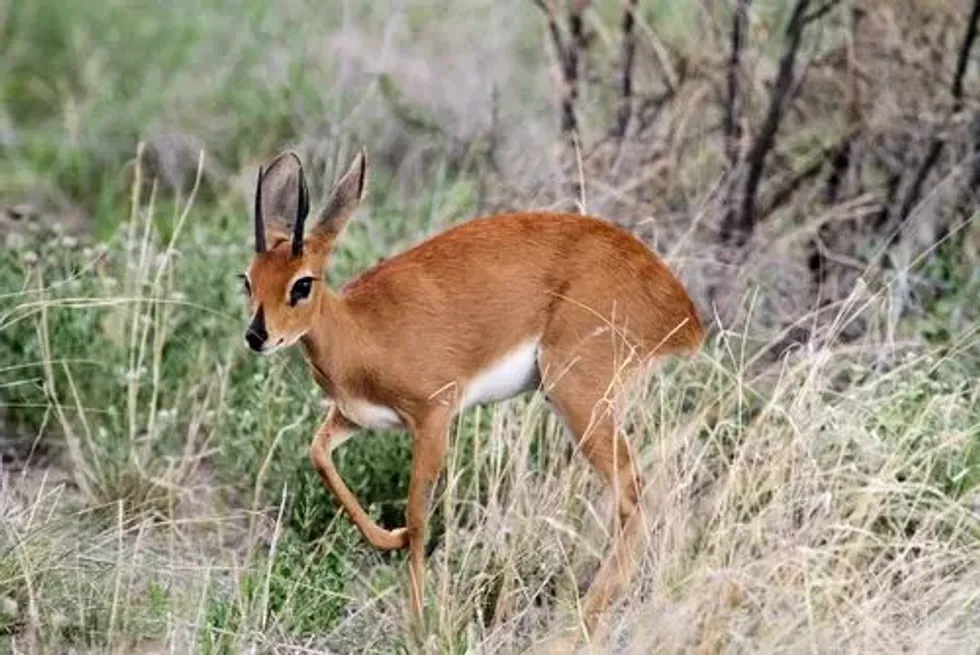Duiker is an antelope found throughout the continent of Africa. The name duiker is coined from the Afrikaans word 'duik' or the Dutch word 'duiken', meaning to dive.
The name is derived from their common practice of diving into vegetation to hide from predators. They have three genera, namely Cephalophus, Philantomba, and Sylvicapra, with a total of 22 species.
They are broadly classified into two types, forest and bush duikers, based on their habitats. The duiker are also found in coastal scrubs and dry forest patches. They are usually diurnal or nocturnal in nature and feed on a variety of plants.
They also eat insects, rodents, and small birds. Blue duikers are also known to eat bird eggs along with plants.
Their breeding seasons range throughout the year, and after the pairs have mated, females give birth to one or two young. The calves are usually precocial or well-developed at birth.
The International Union for Conservation of Nature has listed duiker as species of Least Concern. However, their population has been decreasing in numbers, especially in the case of Zebra duikers. It is in danger due to habitat destruction and intense hunting by local people.
If you liked reading this article, then do check out south china tiger and collared peccary
Duiker Interesting Facts
What type of animal is a duiker?
Duiker is an antelope native to sub-Saharan Africa. It belongs to the family Bovidae and consists of 22 species.
What class of animal does a duiker belong to?
The duiker belongs to the class Mammalia.
How many duikers are there in the world?
There are around 22 species of duiker, and almost all of them are decreasing in population, according to the International Union for Conservation of Nature or IUCN Red List.
Where does a duiker live?
The duiker are distributed throughout the continent of Africa. They are found in Malawi, Mozambique, and parts of Southern Africa. They also live in Central and Western Africa, with their range extending from Senegal to Western Uganda. This African species can be observed to reside in areas such as Angola, Kenya, Nigeria, Uganda, and Zimbabwe.
What is a duiker's habitat?
They are broadly classified into two subgroups on the basis of their habitat. The subgroups are bush and forest duikers. Common duiker is the only species of bush duiker, and they inhabit savanna grasslands.
Their habitat consists of trees that are widely spaced and a herbaceous layer on the ground. Forest duikers include blue duikers and yellow-backed duikers. They are found in tropical rain forests characterized by evergreen trees and continuous rainfall throughout the year.
Who do duikers live with?
They prefer to live in solitude or in pairs and maintain a distance from other individuals. However, they form small temporary groups to gather food and during mating.
How long does a duiker live?
They have an average life expectancy of nine years. However, they live longer in captivity.
How do they reproduce?
Duikers do not have a fixed breeding season and breed throughout the year. They form monogamous pairs, having a single partner throughout their life. Although, male blue duikers sometimes mate with more than one female.
The mating rituals and the process of reproduction slightly vary from one species to the other. In the female common duiker, the gestation period lasts for 4-7 months. Gestation in female blue duikers ranges from 196-216 days.
Females give birth to one or two offspring. Parental care exists among all the species, and both parents look after the young. Blue duiker calves are able to run within 20 minutes of their birth and leave the territory after attaining sexual maturity.
What is their conservation status?
International Union for Conservation of Nature or IUCN Red List has listed most of the duiker species as Least Concern. Some species have also been listed as Vulnerable and Near Threatened. However, the destruction of habitats and intense hunting has resulted in a decline in their population.
Duiker Fun Facts
What do duikers look like?

The sizes, weight, and coloration of the African duiker deer vary from one species to the other. The African common duiker (Sylvicapra grimmia) has a pale color in the drier habitats and a dark gray color in the moist habitats.
The female common duiker does not have horns and is slightly larger than the male. The ones who reside in the mountainous habitat tend to have a thicker coat than those living in forests and savanna.
Yellow-backed duikers have a brown or black colored coat with a yellow triangular mark near their tail. The yellow patch develops almost a month after birth.
Their calves are born with spotted flanks, brown coats, and red underparts, which help them to hide from predators. Both the male and female possess conical horns. Zebra duiker has unique black vertical stripes extending across its mid-torso.
Their head, neck, and limps are red. Both male and female have a pair of horns which are rounded and short.
Red duikers have a reddish-orange coat and greyish-black colored lower legs. The males have short black horns that are slightly larger than the females.
How cute are they?
Yes, they are considered to be cute, and their cuteness stems from their appearance. The color of their coats, the presence of horns, and large eyes make them attractive.
How do they communicate?
Duikers have a great sense of smell and hearing. They emit sharp vocalization, usually a shrill bark, to communicate with their calves or when they face predators.
They also exhibit visual displays by flicking their tails which usually signals danger. They have a preorbital gland, one of the prominent scent glands used in marking their territories or to display social acceptance.
How big is a duiker?
The smallest species of duiker is the blue duiker which has a body length of 21.6-28.3 in (55-72 cm). It is smaller than red duiker.
The yellow-backed duiker is one of the largest species of duiker, with a body length of 45.2-57 in(115-145 cm). It is slightly larger than grey duiker. In comparison, the yellow-backed duiker is slightly shorter than the Indian sambar deer, with an average length of around (160 cm).
How fast can a duiker move?
Common duiker, also known to us as the grey duiker (Sylvicapra grimmia), is the fastest among all the other species of duiker. However, their exact speed is not known.
How much does a duiker weigh?
The blue duiker is the smallest species of duiker; they are 8.8-13.2 lb (4-6 kg) in weight. Yellow-backed duiker is one of the largest duiker species, whose weight is around 99.2-176.3 lb (45-80 kg).
What are their male and female names of the species?
A male duiker is known as a buck, while a female duiker is called a doe.
What would you call a baby duiker?
A baby duiker is usually called a calf or lamb.
What do they eat?
They eat a variety of plants, especially leaves, fruits, flowers, and tubers. They usually feed on the nutritious parts of the plant. They also eat insects along with the meat of rodents and small birds.
Are they dangerous?
Duikers are not dangerous to humans. However, males are territorial and might attack other males if they intrude on their territories.
Would they make a good pet?
Yes, they may make a good pet but are better off living in their natural habitat. However, they even live longer in captivity.
Did you know...
Duikers do not consume water. They usually get their water requirements met from the vegetation that they consume.
How do you say duiker?
The duiker pronunciation is dei-kar in Afrikaans.
What is a duiker in Afrikaans?
The name duiker is borrowed from the Africaans word 'duik', meaning to dive. It is derived from their common practice of diving into the vegetation to hide from predators. This what the duiker Afrikaans' meaning is.
Here at Kidadl, we have carefully created lots of interesting family-friendly animal facts for everyone to discover! Learn more about some other mammals including the African civet, or the black footed ferret.
You can even occupy yourself at home by drawing one on our duiker coloring pages.










